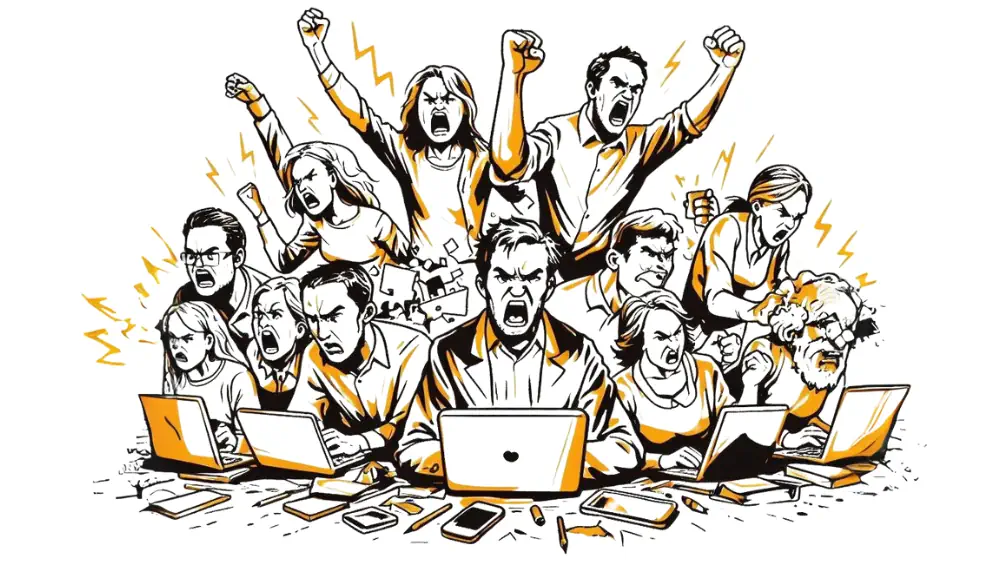 illustration: Bing AI
illustration: Bing AIStatistics show that 16% of respondents admit to being victims of online hate, and 28% have witnessed offensive comments about someone they know. Notably, offensive content more often targets public figures (59%) than people within the respondents’ immediate circles (28%).
Who Posts Hate and Why?
According to the study, 13% of Poles admit to posting offensive comments, most often directed at strangers or companies. Men are twice as likely to be haters - 16% of men confess to such behavior compared to 8% of women. Women, however, more frequently criticize the appearance of people they know personally.
Analysis from the "Hate on the Internet" report shows men are more involved in hateful behavior than women - 16% versus 8%. The motivations differ by gender. Women haters often act out of emotions like jealousy (37%) or dissatisfaction with their own lives (25%), while men cite intolerance of differences (20%) or entertainment (14%).
Motivations for Hate by Gender
| Reason for Hate | Women (%) | Men (%) |
|---|---|---|
| Jealousy | 37% | 21% |
| Dissatisfaction with own life | 25% | 22% |
| Anonymity and impunity | 24% | 22% |
| Releasing negative emotions | 19% | 18% |
| Intolerance of differences | 16% | 20% |
| Seeking attention online | 17% | 13% |
| Entertainment or fun | 7% | 14% |
These data suggest that women are more often driven by personal emotions, while men act more impulsively. However, anonymity in the online space remains a common motivator for both groups.
– The latest report from the "I Don’t Hate - I Motivate" campaign reveals that men are more likely to engage in hateful behavior. About 16% of men admit to this, a figure twice as high as for women – says Ilona Adamska, president of the "In Harmony with Yourself" Foundation and the study’s initiator, quoted by the portal InformacjePrasowe.pl. – Moreover, men more often target brands, companies, and public figures, while women typically criticize other women, especially from their immediate environment.
What is the Target of Hate?
Hate most commonly focuses on appearance (70% of responses), sexual orientation (64%), and political views (38%). Women are more often criticized for their appearance, weight, or age, while men face hate related to sexual orientation, political views, or ethnicity.
Hate Targets for Women:
- Appearance: 70%
- Age: 18%
- Intelligence: 12%
Hate Targets for Men:
- Sexual orientation: 64%
- Political views: 38%
- Ethnicity: 17%
Online hate evokes a range of emotions among both victims and witnesses. The most common reactions are anger (61%), sadness (36%), and anxiety (23%). Women more often report feelings of fear and sadness, while men are more likely to react with indifference or amusement.
The consequences of hate run much deeper. As many as 58% of respondents believe hate lowers self-esteem, and 43% link it to depression and suicidal thoughts. Women are more likely to experience anxiety and depression, while men report aggression toward others.
Social Responsibility to Counteract Hate
The report shows that Poles declare willingness to react to hate, often defending people they know personally rather than public figures. Additionally, 85% of respondents believe hate can have serious financial consequences for companies, and 91% recognize its negative impact on the mental health of those targeted.
However, opinions on the severity of the problem vary by gender. 62% of men think society overreacts to hate, compared to 47% of women who share this view.
Attitudes Toward Hate
| Statement | General Agreement | Women’s Agreement | Men’s Agreement |
|---|---|---|---|
| Hate is a serious health issue | 91% | 97% | 84% |
| Hate is a problem worth fighting | 89% | 94% | 84% |
| The hate phenomenon is exaggerated | 31% | 25% | 37% |
The findings of the "Hate on the Internet" report highlight the complexity of the issue, which requires both educational and legal actions. The "In Harmony with Yourself" Foundation and Maison&Partners hope this study will inspire the creation of a more conscious and empathetic society.
The full report is available for free download at:
https://www.fundacjawzgodziezesoba.pl/raport/
COMMERCIAL BREAK
New articles in section Law in media
Dietary supplement ads in Poland. Who keeps influencers in check?
Newseria, KFi
One in three Polish internet users considers influencer recommendations when deciding on medicines and dietary supplements. Although promotion of such products is regulated, there are still cases of advertising that skirt the law.
SEO Poisoning. Hackers Use Search Engines to Target Businesses
Piotr Rozmiarek
Search engines help us quickly find information, but they can also be used by cybercriminals. SEO poisoning is a tactic where attackers manipulate search engine rankings to place harmful websites at the top of search results.
Phishing in the Cryptocurrency Industry. Fake Recruitments Steal Data
Piotr Rozmiarek
Security researchers have detected a social engineering campaign targeting job seekers in the Web3 industry. The attack aims to conduct fake job interviews via a meeting application that installs information-stealing malware.
See articles on a similar topic:
Children’s Online Safety. Clickmeeting Analysis
KrzysztoF
Over half of surveyed parents believe their children are aware of the dangers lurking online. At the same time, just over 40 percent of respondents admit to taking steps to protect their children’s privacy online.
GDPR in Media. Regulations Complicate Campaign Planning and Execution
BARD
Most Polish news portals and online stores have adopted consent mechanisms designed in a way that makes it hard to refuse consent
Local Media in Poland - Corrections
Bartłomiej Dwornik
The regulations regarding corrections are perhaps the most frequently violated rule in Polish media. There is a clear division between those who never admit to mistakes and those who can humbly accept their faults.
Hate in the Polish Internet. IRCenter Study
Krzysztof Fiedorek
The proportion of hate speech victims is inversely proportional to the age of internet users. The study authors point out that this is directly influenced by the fact that older generations are instilled with the principles of respectful discussion and use the internet less frequently.





























